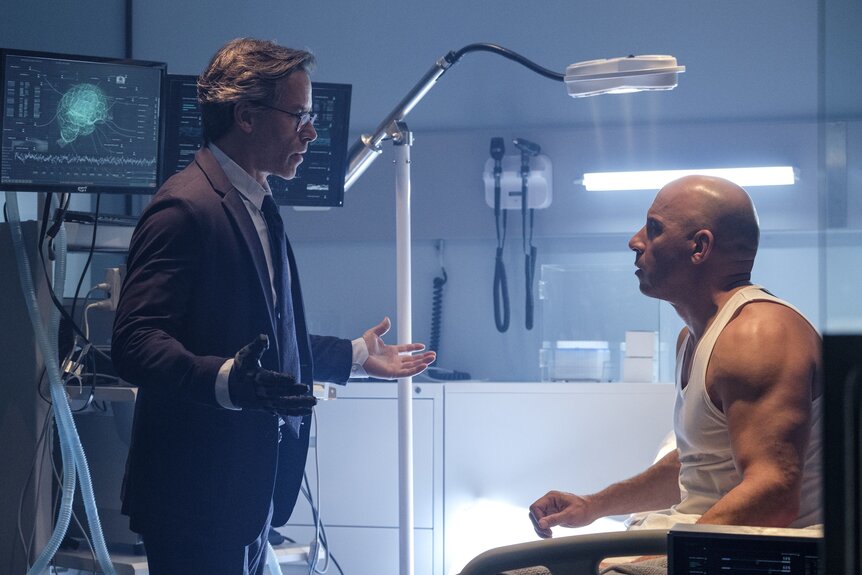Create a free profile to get unlimited access to exclusive videos, sweepstakes, and more!
How do you defeat death, sci-fi style? With nanobots, ice, and computers, of course

Genre fiction is rife with stories about conquering death in some form or fashion. In fact, what some consider the first true science fiction tale, Mary Shelley's Frankenstein, centered on this very notion. In the more than 200 years since Frankenstein's publication, storytellers have imagined myriad ways in which we might keep the reaper at bay, whether through medicine, technology, or other means. While the years wear on, there is little more terrifying than the mystery and emptiness of not being, and we'll try anything, it seems, to stave it off.
Alchemists of old sought the Philosopher's Stone or an elixir of life, and explorers searched for fountains of youth. Today, we're still looking for ways to live longer, perhaps with the help of emerging technologies.
Bloodshot, which recently became available as VOD, imagines a superhero kept alive thanks to self-repairing nanobots in his blood. Cryogenics is another popular idea, as freezing oneself to live longer has been a plot point in Futurama, Fallout, and Captain America and Batman comics, to name a few. The Black Mirror episode "San Junipero" made the idea of a digital afterlife famous.
But do any of these sci-fi ways of living longer have the potential to bear fruit?
CRYONICS
While our history is littered with failed attempts at accomplishing immortality, with foolish individuals chasing improbable solutions, cryonics has the benefit of being based, at least a little, on reality.
Death is the cessation of biological function, followed by the irreversible degradation of the body. We still, even in these modern times, don't have a complete understanding of the moment of death, the precise time at which a person is irretrievably lost.
The definition of death has changed over time, and by some standards we have already accomplished miraculous resurrection. Practices like CPR and life-support systems have succeeded in bringing people back from conditions under which they would have, in other eras, been carted off to the grave.
There's a reason the word "heart" has become synonymous with essential, integral, and necessary. When it stops beating, it's reasonable to assume that a person has died. But have they? If circulation and respiration can be restored quickly enough, an individual can recover to live a more-or-less ordinary life for a while yet. So, surely, death occurs at some later time.
There is, it seems, an interval between the cessation of ordinary biological function and the irreversible degradation of the body wherein a person exists in an unusual state but is not yet truly dead. This is the interval that cryonics intends to exploit.
In the moment that the body stops functioning in its ordinary capacity, decay begins to set in. The bacteria that normally exist in equilibrium within us overload the system and break the body down — at least under ordinary circumstances. Cryonics seeks to lower the body's temperature such that the process of decay is arrested. And there is precedent for this sort of thing.
In 1999, Anna Bagenholm hit the mountains of Norway for a skiing trip, and things went terribly wrong. She fell, landing head-down in a frozen stream. Her friends, two other doctors, attempted to retrieve her but were unable. They called for help, but it was nearly an hour and a half before she was pulled out, at which time Bagenholm was dead. At least, she was dead by ordinary standards. She had no heartbeat and her temperature was 56.7 degrees Fahrenheit (13.7 degrees Celsius).
Most might have left it there, assuming death and mourning her passing, but Mads Gilbert, head of the emergency medical department at the University Hospital of North Norway, thought otherwise.
"We will not declare her dead until she is warm and dead," Gilbert said. And that turned out be a literal lifesaver.
By the time she reached the hospital, it had been nearly two and a half hours since she'd fallen into the water. Bagenholm had received CPR at the hands of her companions on the scene, and, upon reaching the hospital, was put on a heart-lung machine that circulated her blood, slowly bringing it back up to temperature.
Almost a day after her initial death, her heart began to beat, and after 12 days she revived. It wasn't an easy go. It took more than a year for her to be able to recover, but owing to the efforts of her friends and a team of doctors, she is alive and well today.
Bagenholm's story is miraculous but shows that the reduction of oxygen and temperature can slow the effects or normal degradation, allowing doctors time to perform life-saving functions.
Cryonics is based entirely on this notion, that by arresting the normal decay of the body, future medical technology will allow for opportunities to revive individuals who might otherwise be considered dead. It remains to be seen if modern freezing technologies and future medical ability is able to restore the dead to life.
NANOBOTS
In comparison to cryonics, the use of nanotech might seem positively supernatural, but, according to American inventor and futurist Ray Kurzweil, it might be the thing that ends aging and death once and for all.
Human life expectancy has increased rapidly (relatively speaking) over the past several centuries. Not so long ago it might have been reasonable to expect to live to your 30s or 40s. Now the average person can expect to live twice as long. From a certain point of view, we're already living a double life, the sorts of lifespans that might make us seem positively elven to our progenitors.
Kurzweil, however, believes this is just the tip of the iceberg.
According to his estimation, pretty soon we'll be adding time to our life expectancy faster than we can spend it. He imagines a time in which nanobots will course through our bodies, repairing damage before it grows out of control.
We're used to stories of robots taking over the world, intent on human destruction, but there might be an alternate future in which it might just be time for you to decide how you want to spend your infinite afterlife, and by which method you want to get there. Who knows, an infinite life might come calling before you know it.
DIGITAL IMMORTALITY
If physical immortality fails us, we might be able to hold out hope for a digital afterlife. One of the mainstays of both cryonics and other extension technologies is that while we might not be able to restore a person to their previous physical status, we might be able to replicate them in silico.
This sort of extended life relies on a particular suspension of disbelief as it pertains to what a person is.
In short, it relies on the acceptance that you are no more than the emergent properties of your material mind and that those material properties don't rely on a particular material.
If a computer, or a program within a computer, could be made to perfectly replicate all of the functions of your consciousness, then maybe it is indistinguishable from the real thing.
Presupposing that you're willing to take that leap, it's not outside the realm of possibility that future technology might allow for whatever makes you, well, you, to be uploaded into an artificial construct. Neuroscience is forever progressing in its attempts to understand the mind and all of its intricacies.
Meanwhile, computer science progresses at a relatively consistent rate and might one day be capable of replicating all of the many bits and bobs that make a brain work. Presuming that a mind could be coded, down to the cellular or even the molecular or quantum level, maybe you could be duplicated. And if it is indistinguishable from the real thing, then isn't it so?
There are, of course, philosophical questions to be debated, but a digital reconstruction might be better than annihilation. That's for you to decide. In the meantime, research teams are hard at work defining what makes the brain function, what accounts for memory, and what totals up to a human life.
It might just be time for you to decide how you want to spend your infinite afterlife, and by which method you want to get there. Who knows, an infinite life might come calling before you know it.















